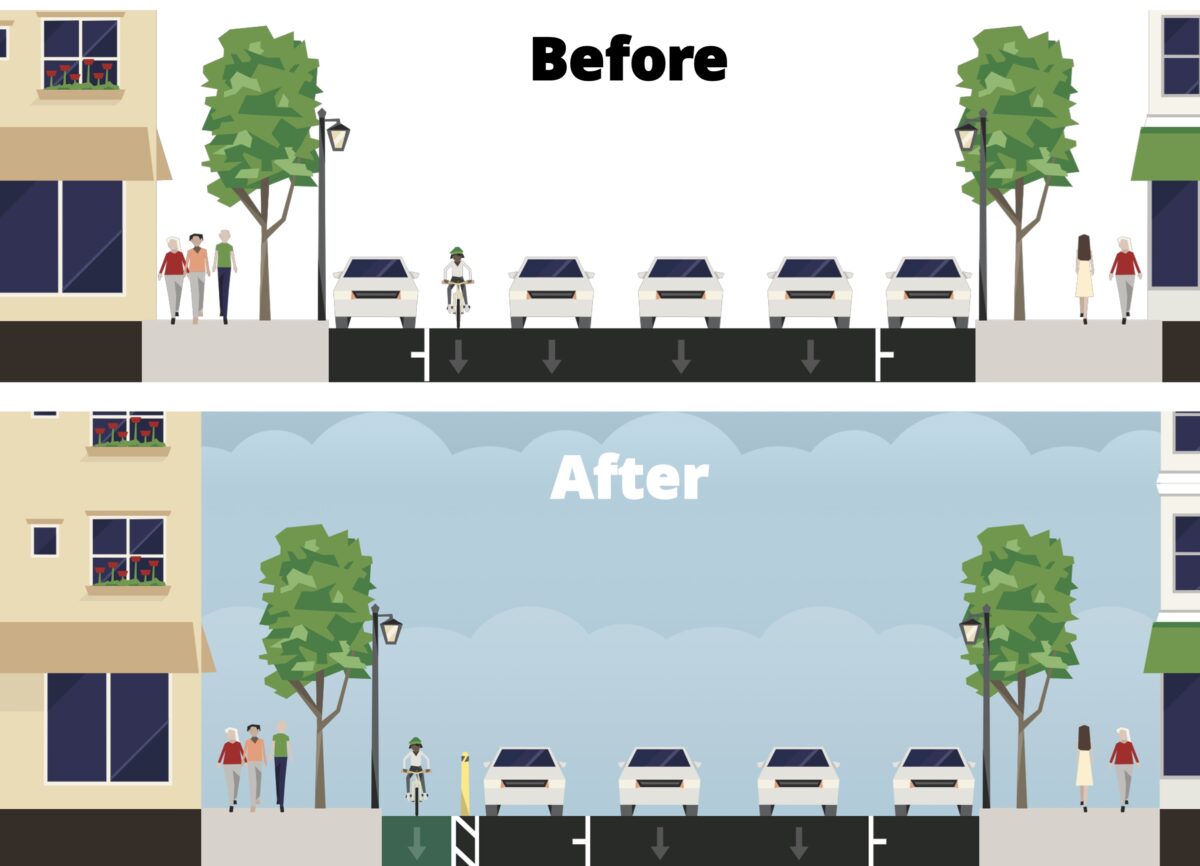
By the end of this year there will be a protected bike lane through Portland’s “Living Room.”
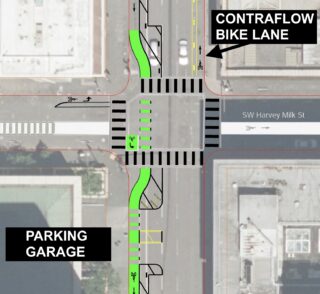
Starting in June, the transportation bureau will begin to build a protected bike lane on Southwest Broadway between Oak and Clay. Broadway is our city’s marquee main street that runs adjacent to Pioneer Courthouse Square (a.k.a. Portland’s Living Room) and through a shopping, cultural, and university district. The project will fill a gap in existing protected bike lanes to the north and south and fulfill a promise of safe cycling access that began 13 years ago with Portland’s first cycle track on Broadway near Portland State University and that we got a glimpse of in 2016 when a group of planners tested a pop-up version of the city’s design in 2016.
On April 11th, the Portland Bureau of Transportation shared newly updated plans (PDF) at a meeting of their Central City in Motion (CCIM) working group. CCIM is a plan adopted by Portland City Council in 2018 that aims to build 18 projects to boost biking, walking and transit rates downtown and in the central eastside.
The plan for Broadway is to continue a parking-protected bike lane design similar to the one already in place on both ends of this project.
PBOT wants to swap locations of the existing bike lane and curbside parking lane on the one-way street. In doing so, they will add width and protection to the bike lane, a move that will reduce space for driving. The current cross-section includes six lanes; two parking lanes, three traffic lanes and one unprotected, narrow, door-zone, bike-only lane. The new cross-section will include five lanes; two for traffic, two for parking cars and one only for bicycle (and micromobility vehicle) users. In some locations, the space for driving will be even smaller: The block between SW Harvey Milk and Oak will be striped with a northbound (contraflow) bike lane which will eliminate space previously used to park cars; and driving space will also be lost at Yamhill and Morrison where curb extensions narrow the intersection width.
Advertisement
As is the rule in cities, when we reduce space for cars, everything else works much better. This project will vastly improve Broadway for walkers and other non-driving road users. People will not only have effectively narrower and safer streets to walk across, they’ll also see big upgrades to crosswalks in the form of more striping (what PBOT calls “high visibility crosswalks”) and fewer car parking spaces near intersections.
As with any bikeway project, the key to its success will be where car users are allowed to cross over it. On Broadway, beyond typical concerns with right-hooks at intersections, a few other issues pop out: There are two major hotels along the project route and there’s a mixing zone planned between Yamhill and Taylor.
On the block between Yamhill and Taylor, PBOT will allow another incursion into the bike lane. Instead of requiring people to turn right at the intersection with Taylor, PBOT has designed a break in the bike lane where car and bike lane users will cross over each other so drivers can make the right turn onto Taylor from a curbside lane. When a CCIM committee member expressed concerns about this design at the April 11th meeting, PBOT project manager Brianna Orr said a combination of outdated signal equipment (that doesn’t allow for a separate bike signal phase) and a high turning volume led to this design choice. PBOT is expected to upgrade the signal in a later phase of the project, but funding has not yet been identified.
Advertisement
“It’s a shame when a facility is an ‘all ages and ability route’ except for one block,” one working group member expressed at the meeting. PBOT’s Orr said there’s still time to consult with engineers and look for other solutions.
Another notable part of the proposed design is the new contraflow bike lane between SW Harvey Milk and Oak where bicycle users will have a left turn lane from eastbound Harvey Milk onto northbound Broadway, where they’ll ride against oncoming lanes of car traffic.
We also see how PBOT has addressed a busy driving into a parking garage just south of Harvey Milk. In order to slow down drivers as they enter the driveway, PBOT plans to install three rubberized, turn-calming curbs to create a 90-degree entry angle (this slows drivers down and encourages better visibility of bike lane traffic).
Another area where PBOT will beef up the bikeway is at the intersection with SW Jefferson where another important bikeway route crosses Broadway. The plan for the northwest corner of Broadway and Jefferson is a mini protected intersection that will utilize rubber curbs and generous use of green pavement coloring to manage traffic flows.
PBOT says construction on this $500,000 “quick build” project is set for June of this year. Once complete, Broadway will form a bikeway couplet with SW 4th, a more substantial capital project PBOT says they plan to break ground on this fall.
UPDATE/CORRECTION, 4/20 at 12:55 pm: This post initially stated that PBOT would maintain three parking spaces curbside in the bike lane near two major hotels for loading and unloading of passengers. That was based on notes from a recent CCIM working group meeting that mentioned a “shared curbside” and a need to “minimize conflicts.” PBOT’s Dylan Rivera has just emailed to clarify that, “Parking spaces will not be curbside. They will be to the east of the bike lane, as shown in Before/After image… Vehicle parking will not be allowed in the bike lane. People will be able to walk across the bike lane to access their parked cars, going to or from the hotels or other destinations.”
We regret the confusion.


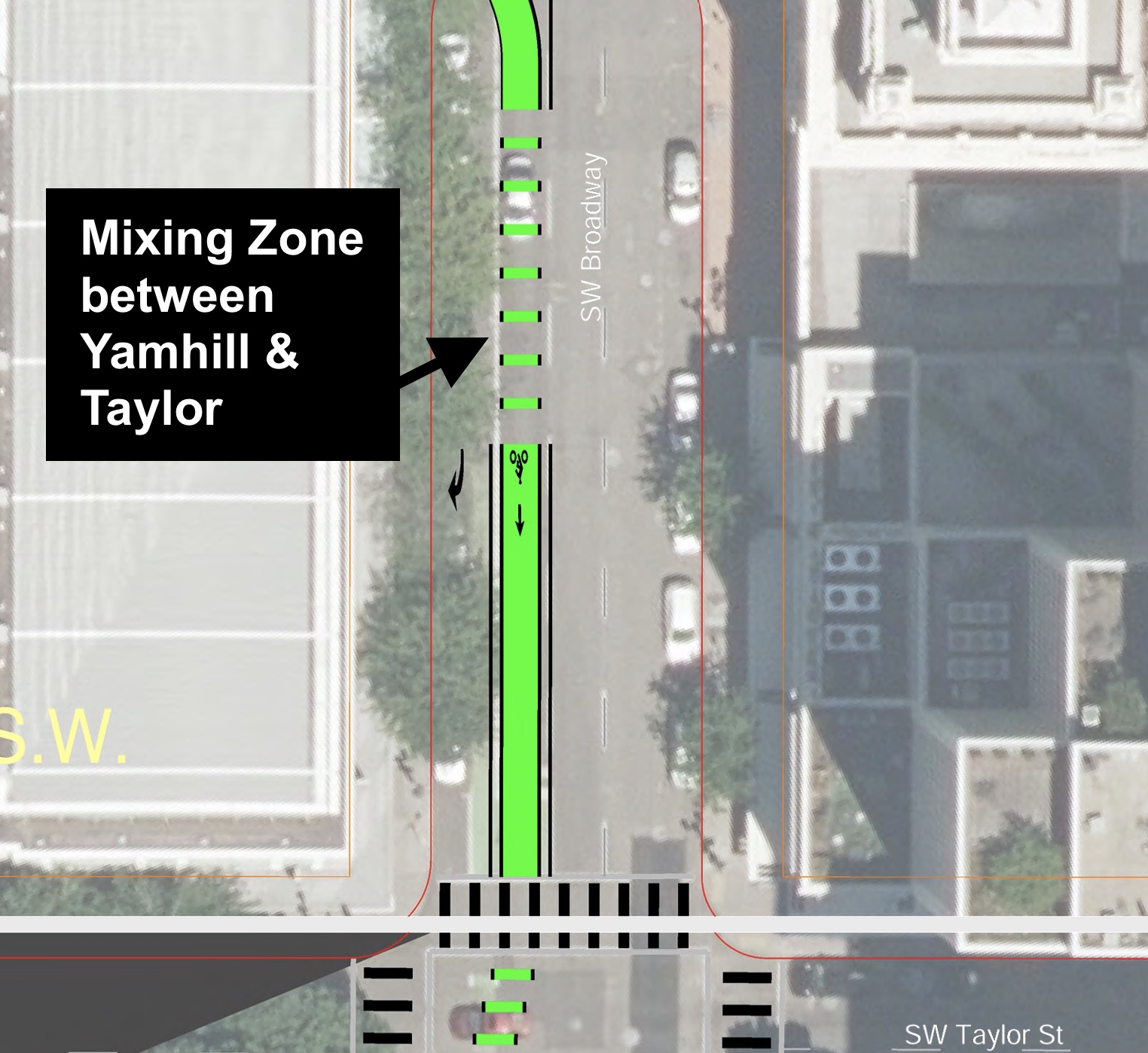
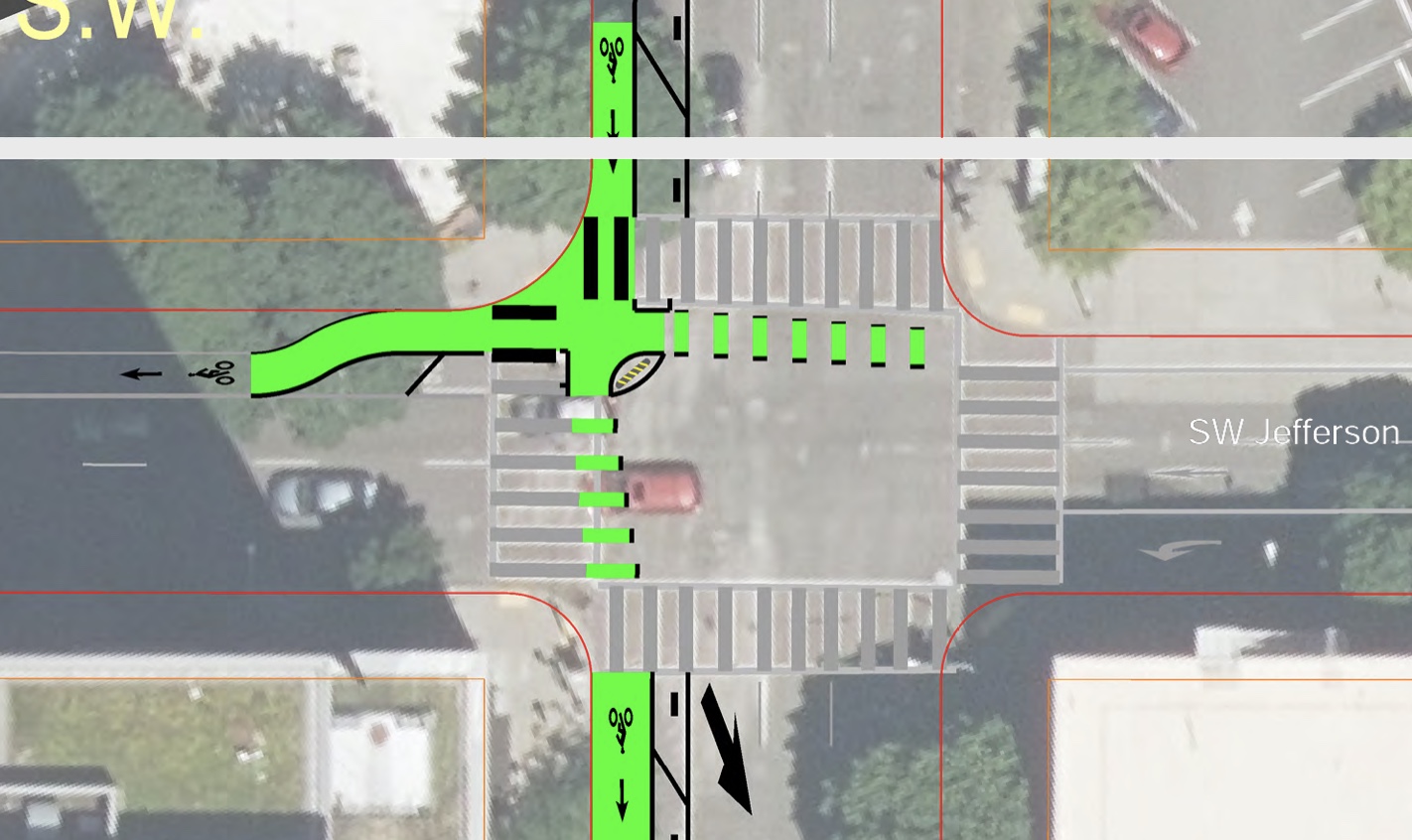
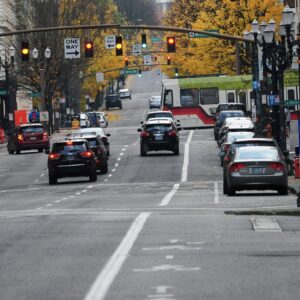
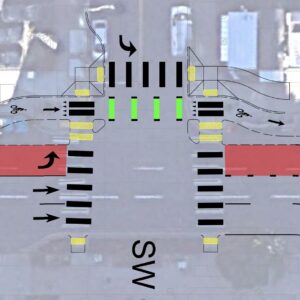
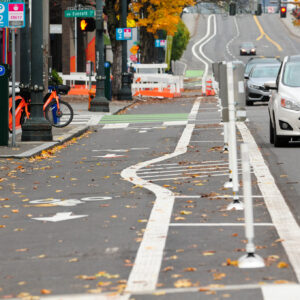

Thanks for reading.
BikePortland has served this community with independent community journalism since 2005. We rely on subscriptions from readers like you to survive. Your financial support is vital in keeping this valuable resource alive and well.
Please subscribe today to strengthen and expand our work.
Couple of things:
1. Is the “protection” simply plastic wands? If so, we should not be calling this bike infrastructure protected.
2. PBOT should make Taylor and Yamhill car-free; then they wouldn’t have to worry about mixing zones
3. Isn’t Jefferson supposed to have a new bikeway on the *left* side of the street soon? If this remains the plan, why would PBOT build a quasi-protected intersection at Broadway and Jefferson with its current right side bike lane configuration?
Thanks.
re: #2. What I meant to say is that Yamhill and Morrison ought to be car-free. PBOT should just ban right turns onto Taylor from Broadway…Voila! No more mixing zone needed.
I strongly agree with point 1. I know that Jonathan has thought about this vocabulary both because he is very careful with his words and because we have discussed it. BikePortland often mirrors the way that PBOT uses the term even though it is inaccurate, to me this feels like when many news outlets just reprint police reports without actually evaluating the veracity of the report. Wands do not equal protection and we shouldn’t just say they do because that is what PBOT prints on their press releases. That said in this case the lane also appears to be protected by parked cars so while I would like to see permanent physical barriers to people driving their cars into the bike lane these lanes do seem more protected than just wands next to a travel lane.
I hear you two loud and clear. I totally disagree however, with the equivalencies your making to police Bjorn. The fact is: This will be a bike lane protected from other road users by several things: parked cars, a painted buffer zone, plastic delineator wands. I agree with both of you that all three of those are not great protectors, but I think calling this lane “protected” is fine in this context. I’m always re-assessing and will consider different ways to say and frame this stuff in the future, but let’s not kill the messenger here.
The plastic wand provides as much protection as my shirt and paint doesn’t provide any protection at all. Cyclists are left depending on motorist to drive and park their cars to provide protection from other motorists.
Its not that they aren’t “great” protectors, its that 2 out of 3 don’t provide any level of protection at all.
I have never been sideswiped while in a wand-buffered lane. I have been sideswiped in a non-buffered lane with no wands. Saying wands and buffers offer no protection is true in a limited sense, but that specific sense ignores the very real effect that the wands have on passing distance, which is a protection that I personally find very meaningful.
Based on the number of broken and snapped wands, I think that might just be coincidence.
With that logic we should also consider a single line bike lane to be protected, as that does improve passing distance for motorists.
I’m just saying, if we call platinum level, physically protected bike lanes “protected bike lanes” and we call plastic wands with paint “protected bike lanes”, the meaning is going to gravitate towards the useless one.
And PBOT has a terrible track record on this. PBOT has “traffic diverters” that intentionally don’t divert traffic. We have “greenways” that are designed primarily with motorist use in mind, and they have “multi-use paths” that don’t meet basic definitions of a MUP. They are an agency that accomplishes little but is never shy to trumpet and oversell what little they do. Refusing to use their language when they oversell their poorly constructed infrastructure is just one way of pushing back.
Plastic bendy straws!
Generally great news, but this…
….is a bizarre solution to the problem. Why not do something like Seattle has done on SW 2nd Ave, in front of the Courtyard Marriott? This could be done with one of the pre-fabricated Zicla platforms if there isn’t the time / budget to do it out of concrete.
Yes it does seem odd. And I’m still trying to figure out exactly what the plan is. Stay tuned.
That Seattle treatment seems really decent. Sort of like a reverse of the bus platforms with bike lanes.
Yes I lived in Seattle and bike past those areas a few times, and they worked fairly well. You do have to be a bit on guard for people coming and going through there. That said, much better than people essentially parking in a bike lane. I’m doubtful of the 3 min policing of this…
I totally agree. Seems backwards to let cars just park and block the entire width of the new protected bike lane, when theres an adjacent parking lane still. PBOT PMs always say ‘only as good as the weakest link’ part, so they need to act like it. Also what a joke for PBOT to say that they’ll enforce some max loading time: we all know they wont.
Here’s a great opportunity for PBOT to really carrots and sticks and say:
1) we are providing this world-class bike lane at the foot of your hotel
2) no more stress between arriving patrons and the door-zone bike-lane users
3) if you want curb level loading: pay PBOT to install a Zicla platform (I’m gonna guess its a funding issue why thats not on the table), until then use the parking lane or unload/load around the corner
Allowing cars to park for unloading further normalizes the view that bike lanes can be used for temporary car parking. And what are bike riders supposed to do while a car unloads, wait 3 minutes or, if the car parks for a longer time, wait until the towing truck comes?!? This is not a compromise.
Wow that platform looks great. Also, these planter boxes look and function so much better for bike lane protection than the plastic whiffleball bats, I mean wands.
Well, there’s pretty much no chance that the 3-minute limit for loading and unloading is in front of the hotels is going to work. Hopefully there’s a decent backup plan (like, they could just use the parking lane outside the bike lane and walk across the bike lane).
Always with little jogs and tight radius wiggles for cyclist going straight. I’d like to see these updates solve intersection packaging issues by using deviations, micro chicanes, if you will, built into car lanes not the bike lane.
That ridiculous wiggling and joggling is also caused by PBOT’s unwillingness to fund bike signals (that mitigate left hook risk). It may take some ambulance trips for PBOT to suddenly materialize funding for signals in the future.
*right hook
This city has no interest or investment in either the active or passive enforcement of its rules, nor can it maintain what it builds, but sure, let’s double down with half a million dollars on what’s failing on NW Broadway?
My neighborhood is still begging for basic traffic calming like barrels and PBOT says it can’t find the money.
We have a 40 mile loop of tent camps…No money or will to keep real bike paths open
but there is always stupid little show projects in this city that doesn’t work anymore.
Northeast Broadway is just an accident waiting to happen but no one rides downtown anymore so it doesn’t matter. They have cyclists changing lanes and dodging cars that don’t know where to go for a mile.
I do. I ride downtown on Broadway. It usually works for me quite well, and now I’m even more excited for this update.
Me too – I ride on Broadway regularly, though I’m not really excited about these changes. Give me a straight painted bike lane and I’m happy.
“As is the rule in cities, when we reduce space for cars, everything else works much better. This project will vastly improve Broadway for walkers and other non-driving road users…”
Since I walk much more than bike downtown, that’s the paragraph I honed in on. Shorter crossings with better visibility, and walking next to a bike lane instead of cars are significant improvements.
Several of the biking-related criticisms seem thoughtful. I hope they can get addressed.
Personally I trust PBOT on engineering, though others, critics, are saddened by change.
Serious question. When we build a bike boulevard or equivalent, on, say the SW Park Blocks, or NW Flanders, do we remove the bike lanes on the adjacent routes?
What is the thinking in professional bike engineering theory and literature? What are the terms around this question?
Fascinated by that left turn only bike lane from Harvey Milk… That seems to be a first!
I hope the hotel situation conversation advances a little further that ‘just let drivers load in it’, but other than that: this kinda kicks a**.
I’m excited to see the language of the TSP for major city bikeways actually be used with teeth to remove parking and unneeded travel lanes.
Next MAJOR CITY BIKEWAY we need to talk about:
S
A
N
D
Y
B
O
U
L
E
V
A
R
D
I live off of Sandy out in the 70s and I would love to be able to bike down and around it safely.
Do you know any advocacy things I could get involved in related to that?
BikeLoud PDX! You can help start advocacy for that sort of infra. There’s a general BL PDX meeting tonight.
I agree. I make that left turn fairly often.
I laughed and laughed when I read the caption underneath the first photo, which said “the bike lane will be maintained.” When has a so-called protected bike lane in Portland ever been maintained? Installing the wands ensures it’ll never – or hardly ever – be swept. PBOT is okay at building stuff but fails completely at maintaining stuff.
I agree. NW broadway bike lane is a disaster as you head towards the bridge. It’s full of leaves, garbage, and tent detritus.
Can we PLEASE move these safety improvements all the way to NE Broadway too?
Hmm…I don’t know, it seems like this money could be better spent elsewhere, such as in areas east of 82nd Avenue, where the city continues to underfund roads and sidewalks and pretty much everything else. Why are we going to spend this money to “protect” the bicyclists who already feel comfortable biking on SW Broadway when there are huge swaths of outer east Portland that don’t even have sidewalks, where children are walking in streets to get places, including to/from school. I was biking all around downtown Portland in the middle of busy roads as a 14 year old, and all over the eastside on a BMX bike as a kid as young as 7 years old, including busy streets. Sure, there’s more traffic now, but we should reprioritize our money to pave roads, to make sidewalks and to ease traffic between 82nd – 162nd all over east Portland before spending more money on some new bike lanes in downtown.
I applaud the continued improvements by the city, and I continue to be awed by the expense of painted lines and adhesive installed tubular markers. Bicycle vehicular deterrents, such as a separated half raised, colored, with beveled transition lanes, as designed in other cities, especially in some EU countries, sporting active transportation options might serve as an augmentation / replacement of the “Tubular Markers” (Reference https://www.oregon.gov/odot/Engineering/Docs_TrafficEng/TCP-Design-Manual.pdf). Certainly the tubular marker is visually hard to run over when driving, but the markers are designed to have “No significant effect on control or trajectory of an impacted vehicle”. I guess neither will the cyclist that might be in the vehicles trajectory.
Rumble strips, now common on the sides of highways, also do not stop a vehicle from crossing, yet they are having a positive impact on waking up the drifting/napping/distracted on cell phone drivers. Similarly, perhaps a raised bit of pavement (wedge) that could be safely traversed by bicycle might tend to help realign the vehicle to the vehicular lane. Unfortunately if putting down Tubular Markers and painting is $.5M, adding tarmac for raised bike lanes might add a bit to the already tight budget. I recall one accounting maven rejiggering the bicycle/pedestrian budget by allocating all the space between highway white lines and the edge of the gravel as ‘bicycle lane funds’, which on a roadway > 25mph is unconscionable, rumble strips, tubular markers or not. Perhaps it is good fortunately that earlier projects did not go the route of more permanent raised lanes as an option. Our continuous improvement and refinement of lane ideas would not be as flexible. So I applaud the city planners on trying new designs, iteratively improving paths and trying to build a safer multi-modal transportation system including bicycles, buses, light rail, street cars and automobiles. I am equally wary that natural paint erosion might allow reclamation of the streets for alternative vehicular uses with a simple change in political climate.
At some point perhaps there will be a good enough design where we can start building in better raised paths, angled pavement, and appropriate traffic corrections that will help safely separate the vehicles from the more active transportation options that still maintains safety for both sides of the discussion. Are we there yet? Can we encourage our city planners to take the next brave steps?